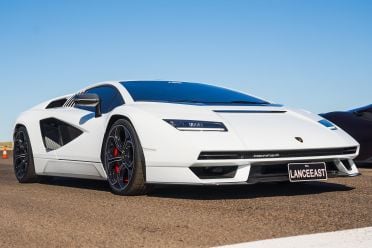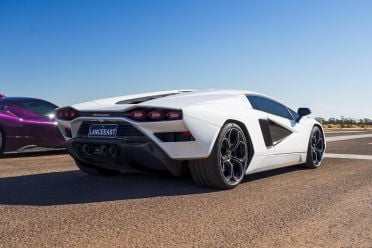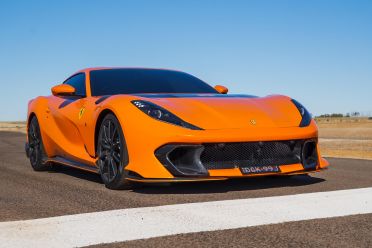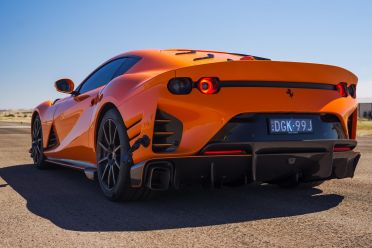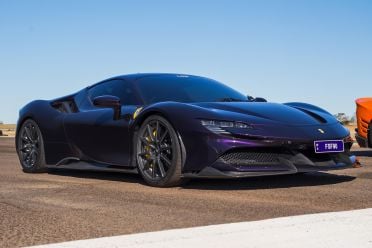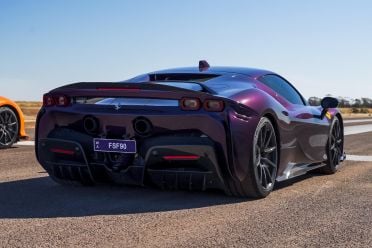Our drag racing series continues – and this time we’re bringing out the big guns!
What’s the context of this drag race? Good question. We tried to come up with a reason for it, but we couldn’t – outside of it probably being a heap of fun.
Just like our first drag race, we’re going to throw the Hyundai Ioniq 5 N into the mix to give you an idea of what an attainable fast electric car can do in comparison to these supercars.
Thanks again to Hyundai for helping cover the cost of putting this series together (it’s MEGA expensive to do, so without support it wouldn’t have happened, you can read more about that here).
The cars
We’ve got to start with the Lamborghini Countach. It’s a throwback to the Countach of old in design – but unlike the original Countach, this uses a hybridised drivetrain from the Lamborghini Sian.
It’s a 6.5-litre naturally aspirated V12 that produces 575kW of power alone. It combines with a 48V e-motor that produces 25kW which combines to offer a peak of 599kW.
This engine and electric motor are mated to an all-wheel drive system, along with a seven-speed automated manual transmission. It’s the most expensive car of this bunch (being limited to just 112 units) priced at around $5 million.
The other V12 in this group is the epic Ferrari 812 Competizione. It’s the go-faster version of the front-engined V12 Ferrari platform.
It uses a naturally aspirated 6.5-litre petrol V12, mated to a seven-speed dual-clutch transmission and makes 610kW of power and 692Nm of torque.
It also has a price tag of $1,035,768 before on-road costs and options – it genuinely looks like they just pressed a bunch of numbers after the 1 to land on that price!
The Ferrari SF90 has the lowest cylinder count…but it packs a mega punch.
It uses a turbocharged V8 that produces 575kW of power on its own. But, it’s mated to an plug-in hybrid electric drivetrain (three electric motors) that produces an additional 162kW for a whopping combined power output of 735kW, with 800Nm of torque available.
It uses an eight-speed dual-clutch transmission and it’s all-wheel drive. It’s priced at around $1 million before on-road costs… and options.
The attainable challenger
Priced from $111,000 before on-road costs, the fully electric Hyundai Ioniq 5 N uses a dual-motor all-wheel drive powertrain producing 448kW of power and 740Nm of torque.
Those outputs increase to 478kW and 770Nm with the N Grin Boost function – which can be mated to the launch control function as well.
It has a claimed 0-100km/h time of 3.4 seconds with the N Grin Boost function active.
It also has a bunch of other functions like the ability to destroy tyres, make engine sounds, and even pulse fictional gear shifts to make it feel like an internal-combustion car with a DCT.
The results
The results genuinely surprised us. The Countach fires out of the blocks like a race car, which made it a little hard for the 812 Competizione to keep up. But it was a different story during the rolling race where things were a bit closer.
But it was all over when the SF90 got involved. It treated the Countach as if it was a toy with flat batteries. It walked the Lamborghini like nothing else – genuinely crazy stuff.
The final run with the Hyundai wasn’t a massive surprise – but it was interesting how well it managed to keep up – especially considering it’s worth 45 times less than the Countach!
| Vehicle | 0-100km/h | 80-120km/h | 1/4 mile | 0-200km/h |
|---|---|---|---|---|
| Ferrari SF90 Stradale | 3.09 | 1.79 | 10.30s @ 233.99km/h | 7.95s |
| Lamborghini Countach LPI 800-4 | 3.24 | 1.72 | 10.77s @ 211.43km/h | 9.56s |
| Hyundai Ioniq 5 N | 3.52 | 1.86 | 11.32s @ 195.92km/h | – |
| Ferrari 812 Competizione | 3.79 | 1.57 | 10.99s @ 220.33km/h | 9.33s |
Comment your thoughts below!
MORE: Drag race | Hyundai v Lamborghini v Ferrari v Porsche v Brabus Mercedes-AMG
MORE: Everything Hyundai Ioniq 5

